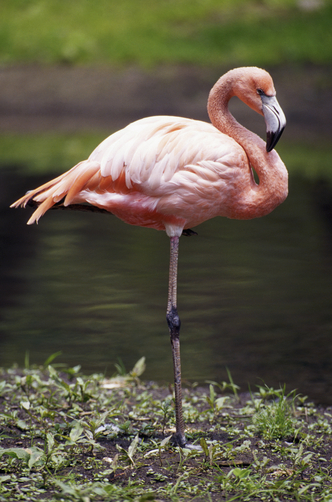Tall, pink flamingos are greater flamingos.
- Greater flamingos have the scientific name Phoenicopterus roseus, and are from the wading bird family, Phoenicopteridae, that only consists of six species of flamingos.
- Greater flamingos are native to areas in Africa, Europe’s south and South Asia.
- Greater flamingos are titled as the world’s largest flamingo, with figures of approximately 110 to 150 centimetres (43 to 60 inches) in height and 2 to 4 kilograms (4.4 to 8.8 pounds) in weight; with records of 187 cm (just over 6 feet) and 4.5 kg (10 lb).
- Greater flamingos have red feathers in some areas, and black flight feathers, but they are well known for their pink-white feathers that are best seen when the bird is standing, although flamingos are born with white and grey feathers that are absent of pink colouration for two years or more.
- Greater flamingos obtain their pink coloured body and plumage by eating organisms that contain carotenoid pigments, that are mostly found in the algae they eat, and if their diet consists mostly of algae, they will be a deeper colour pink than those that feed mainly on shrimp and the like.
Adult Flamingo
Image courtesy of National Geographic
- The Greater flamingo’s diet mainly consists of shrimp, tiny fish, seeds, blue-green algae and other algae, molluscs and plankton, and they obtain their food by filtering the food from water in their bill.
- Greater flamingos can live to be over 60 years old in captivity, with the oldest Greater in captivity dying at an age of around 83 years old in Australia’s Adelaide Zoo, in early 2014.
- The tongues of Greater flamingos were historically eaten luxuriously by Roman emperors.
- Greater flamingos generally live in colonies, which helps to protect them from predators, that can be as large as a thousand or more birds, in habitats of lakes, particularly alkaline lakes, and mudflats.
- When calling, greater flamingos produce a sound like a honk of a goose, and they lay one white egg per season in a nest of mud.
Bibliography:
Greater Flamingo, 2014, Wikipedia, http://en.wikipedia.org/wiki/Greater_Flamingo
Greater Flamingo, n.d, Adelaide Zoo, http://www.zoossa.com.au/adelaide-zoo/animals-exhibits/animals/birds?species=Greater%20Flamingo







